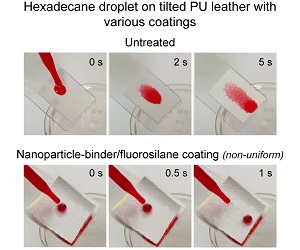both of the leathers become superhydrophobic, with TA about 2° and as expected, the coatings were superoleophilic. After the application of the fluorosilane coating, surfaces became superoleophobic with hexadecane CA of about 157° and TA of about 3°. As shown in Fig. 1 (bottom), the hexadecane droplet just rolls-off of a 10° tilted PU sample. However, the superoleophobicity was found to be non-uniform. It was because the plasticizers in the synthetic leather leach out to top of the surface via capillary action to make the surface chemically active 3.

Figure 1: Photographs comparing the hexadecane repellency on untreated and nanoparticle-binder/fluorosilane coated PU leather 3.
Further tests were performed on the coatings. The nanoparticle-binder coating removed about 90% of the particles in comparison to the 10% of the particles removed by the untreated leather. The untreated is less efficient because it is liquiphilic, hence a droplet will slide on it instead of rolling. Next, the CA of about 160° and TA about 2° remained the same up to 70°C. Around 80°C, the leather starts to lose its superhydrophobicity. It is believed that the polymer in the leather reaches its glass transition temperature, which is about 80°C for PVC 5. In addition, 80°C also happens to be a typical temperature inside an automobile on a hot day 6. That may be a reason why one feels leather being sticky on a hot day. Lastly, after a wear test, some burnishing was observed for the nanoparticle-binder coating, and some loss of TA. When a water droplet was allowed to roll across the wear track, TA increased from 2° to 7°. A TA of under 10° maintains self-cleaning properties.
REFERENCES: 1. Bhushan, B. Biomimetics: bioinspired hierarchical-structured surfaces for green science and technology. (Springer International, 2016).
2. Ma, J., Zhang, X., Bao, Y. & Liu, J. A facile spraying method for fabricating superhydrophobic leather coating. Colloids Surf. A: Physicochem. Eng. Aspects 472, 21–25 (2015).
3. Gurera, D. & Bhushan, B. Fabrication of Bioinspired Superliquiphobic Synthetic Leather with Self-Cleaning and Low Adhesion. Colloids Surf. A: Physicochem. Eng. Aspects (in press) (2018). doi:10.1016/j.colsurfa.2018.02.052
4. Bhushan, B. Introduction to Tribology. (Wiley, 2013).
5. Drobny, J. G. Handbook of Thermoplastic Elastomers. (William Andrew Publishing, 2007).
6. Manning, R. & Ewing, J. Temperature in Cars Survey. (Royal Automobile Club of Queensland Limited (RACQ) Vehicle Testing Authority, 2009).